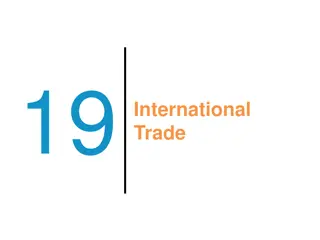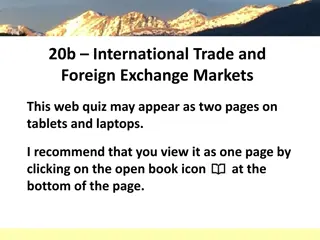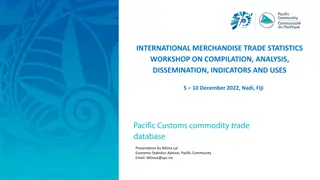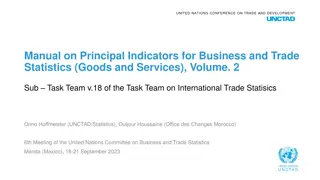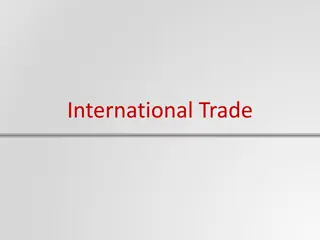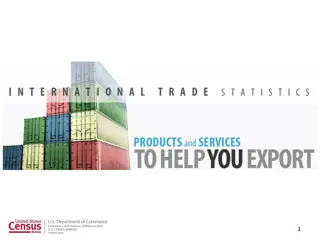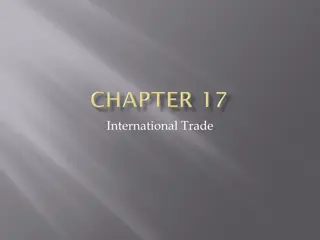International Trade: Determinants and Impacts
Explore the key determinants of international trade, including comparative advantage and world prices. Understand how countries decide to import or export goods and the effects of free trade on domestic and world prices. Discover the winners and losers from trade and the arguments for restricting trade practices.
Download Presentation

Please find below an Image/Link to download the presentation.
The content on the website is provided AS IS for your information and personal use only. It may not be sold, licensed, or shared on other websites without obtaining consent from the author.If you encounter any issues during the download, it is possible that the publisher has removed the file from their server.
You are allowed to download the files provided on this website for personal or commercial use, subject to the condition that they are used lawfully. All files are the property of their respective owners.
The content on the website is provided AS IS for your information and personal use only. It may not be sold, licensed, or shared on other websites without obtaining consent from the author.
E N D
Presentation Transcript
9 Application: International Trade
Contents The Determinants of Trade The Equilibrium without Trade The World Price and Comparative Advantage The Winners and Losers from Trade The Arguments for Restricting Trade CHAPTER 9 APPLICATION: INTERNATIONAL TRADE 2
Chapter 7 Figure 3 How the Price Affects Consumer Surplus (a) Consumer Surplus at Price P1 Price A Consumer Surplus (ABC) + Total Payment (OBCQ1) = Willingness to Pay (OACQ1) Consumer Surplus P1 B C Total Payment Demand 0 Q1 Quantity of Steel
Chapter 7 Figure 6 How the Price Affects Producer Surplus (a) Producer Surplus at Price P1 Price Supply B P1 C Producer surplus Total Revenue (OBCQ1) = Production Cost (OACQ1) + Producer Surplus (ABC) Production Cost A 0 Q1 Quantity of Steel
Figure 1The Equilibrium without International Trade Price When there is no international trade, a country s domestic quantity demanded must be equal to its domestic quantity supplied. of Steel Domestic supply Consumer Surplus So we get the familiar outcome we saw in Chapter 4. Equilibrium Producer Surplus price The equilibrium price when there is no international trade will be called the domestic price. Domestic demand 0 Quantity of Steel Equilibrium quantity
The Determinants of Trade: The World Price and Comparative Advantage If the country opens up to international trade, will it be an importer or exporter of steel? 6 CHAPTER 9 APPLICATION: INTERNATIONAL TRADE
The World Price and Comparative Advantage The effects of free trade can be shown by comparing the domestic price of a good and the world price of the good. The world price is the price that prevails in the world market for that good. 7 CHAPTER 9 APPLICATION: INTERNATIONAL TRADE
The World Price and Comparative Advantage If a country has a comparative advantage in steel production, then its domestic price is less than the world price In this case, the country will be an exporter of the good. 8 CHAPTER 9 APPLICATION: INTERNATIONAL TRADE
The World Price and Comparative Advantage If the country does not have a comparative advantage, then the domestic price is more than the world price, and In this case, the country will be an importer of the good. 9 CHAPTER 9 APPLICATION: INTERNATIONAL TRADE
Figure 2 International Trade in an Exporting Country Price of Steel Domestic supply Price after trade World price Price before trade Domestic demand Exports 0 Quantity of Steel Domestic quantity demanded Domestic quantity supplied
Figure 2 How Free Trade Affects Welfare in an Exporting Country Price of Steel Domestic supply Exports A Price after trade World price D B Price before trade C Domestic demand 0 Quantity of Steel
The Gains and Losses of an Exporting Country If the world price of steel is higher than the domestic price, the country will be an exporter of steel when trade is permitted. Domestic buyers will have to buy steel at the higher world price; so, they will buy less steel. Domestic producers will sell steel at the higher the world price; so, they will sell more steel. There will be a domestic surplus of steel. This surplus will be exported. 12 CHAPTER 9 APPLICATION: INTERNATIONAL TRADE
The Gains and Losses of an Exporting Country Domestic producers of the exported good are better off Domestic consumers of the exported good are worse off. Trade raises the economic well-being of the nation as a whole That is, the gains of producers exceed the losses of consumers. 13 CHAPTER 9 APPLICATION: INTERNATIONAL TRADE
Figure 3 International Trade in an Importing Country Price of Steel Domestic supply Price before trade Price after trade World price Domestic demand Imports Quantity of Steel 0 Domestic quantity supplied Domestic quantity demanded
Figure 3 How Free Trade Affects Welfare in an Importing Country Price of Steel Domestic supply A Price before trade B D Price after trade World price C Imports Domestic demand 0 Quantity of Steel
The Gains and Losses of an Importing Country If the world price of steel is lower than the domestic price, the country will be an importer of steel when trade is permitted. Domestic buyers will buy steel at the lower world price; so, they will buy more steel. Domestic producers will sell steel at the lower the world price; so, they will sell less steel. There will be a domestic shortage of steel. This shortage will be filled by imported steel. 16 CHAPTER 9 APPLICATION: INTERNATIONAL TRADE
The Gains and Losses of an Importing Country Domestic producers of the imported good are worse off Domestic consumers of the imported good are better off. Trade raises the economic well-being of the nation as a whole That is, the gains of consumers exceed the losses of producers. 17 CHAPTER 9 APPLICATION: INTERNATIONAL TRADE
The Winners And Losers From Trade Irrespective of whether a country exports a good or imports it, the gains of those who gain exceed the losses of those who lose. That is, the total surplus always increases. And yet, tariffs, which are taxes on imported goods, are quite popular. Why? 18 CHAPTER 9 APPLICATION: INTERNATIONAL TRADE
The tax on imports enables domestic producers of the imported good to charge higher prices. So, they gain. The consumers of the imported good are forced to pay higher prices. So, they lose. The gains of the producers are smaller than the losses of the consumers. So, the nation as a whole is worse off. EFFECTS OF A TARIFF 19
Effects of a Tariff A tariff is a tax on goods produced abroad and sold domestically. Tariffs raise the price of imported goods above the world price by the amount of the tariff. So, Domestic price = World price + Tariff This reduces trade and, therefore, the benefits of trade 20 CHAPTER 9 APPLICATION: INTERNATIONAL TRADE
Figure 4 The Effects of a Tariff For simplicity, it is assumed here that this country is a so-called small country. That is, events in this country such as the imposition of a tariff do not affect the world price. Price Domestic supply Equilibrium without trade Price with tariff Tariff Price without tariff (free trade) World price Imports with tariff Domestic demand S S D D Quantity of Steel 0 Q Q Q Q Imports without tariff
Figure 4 The Effects of a Tariff Price of Steel Consumer surplus before tariff Domestic supply Producer surplus before tariff Equilibrium without trade Price World price without tariff Domestic demand QS QD Quantity of Steel 0 Imports without tariff
Figure 4 The Effects of a Tariff Price of Steel Consumer surplus with tariff Domestic supply A Equilibrium without trade B Price Tariff with tariff Price World price without tariff Imports with tariff Domestic demand QS QD QS QD Quantity of Steel 0 Imports without tariff
Figure 4 The Effects of a Tariff Price of Steel Domestic supply Producer surplus after tariff Equilibrium without trade Price Tariff with tariff C Price World price G without tariff Imports with tariff Domestic demand QS QD QS QD Quantity of Steel 0 Imports without tariff
Figure 4 The Effects of a Tariff Price of Steel Domestic supply Government s Tariff Revenue Price Tariff with tariff E Price World price without tariff Imports with tariff Domestic demand QS QD QS QD Quantity of Steel 0 Imports without tariff
Figure 4 The Effects of a Tariff Price of Steel Domestic supply When a policy reduces the total surplus, the reduction is called the deadweight loss of the policy. A Deadweight Loss B Price Tariff with tariff C D E F Price World price G without tariff Imports with tariff Domestic demand QS QD QS QD Quantity of Steel 0 Imports without tariff
Effects of a Tariff A tariff reduces the quantity of imports and moves the domestic market closer to the no-trade equilibrium. Buyers of the imported good are worse off Domestic sellers of the imported good are better off Total surplus decreases by an amount referred to as a deadweight loss. That is, the loss to the nation s buyers of the import-competing good exceed the gains to the nation s sellers of that good 27 CHAPTER 9 APPLICATION: INTERNATIONAL TRADE
The Lessons for Trade Policy Tariffs raise domestic prices. reduce the welfare of domestic consumers. increase the welfare of domestic producers. cause deadweight losses. Free trade maximizes total surplus 28 CHAPTER 9 APPLICATION: INTERNATIONAL TRADE
The Winners and Losers from Trade: Other Benefits of International Trade Increased variety of goods Lower costs through economies of scale Increased competition Higher incentives for innovation Enhanced flow of ideas 29 CHAPTER 9 APPLICATION: INTERNATIONAL TRADE
The Arguments For Restricting Trade Jobs are shipped abroad National Security is endangered Infant Industries need to be shielded Unfair Competition Cheap labor Lax environmental standards Hard for domestic regulators to keep out defective or harmful imported goods Protection-as-a-Bargaining Chip Increasing inequality 30
Summary The effects of free trade can be determined by comparing the domestic price without trade to the world price. A low domestic price indicates that the country has a comparative advantage in producing the good and that the country will become an exporter. A high domestic price indicates that the rest of the world has a comparative advantage in producing the good and that the country will become an importer. 31 CHAPTER 9 APPLICATION: INTERNATIONAL TRADE
Summary When a country allows trade and becomes an exporter of a good, producers of the good are better off, and consumers of the good are worse off. When a country allows trade and becomes an importer of a good, consumers of the good are better off, and producers are worse off. 32 CHAPTER 9 APPLICATION: INTERNATIONAL TRADE
Summary A tariff a tax on imports moves a market closer to the equilibrium than would exist without trade, and therefore reduces the gains from trade. Import quotas will have effects similar to those of tariffs. 33 CHAPTER 9 APPLICATION: INTERNATIONAL TRADE
Summary There are various arguments for restricting trade: protecting jobs, defending national security, helping infant industries, preventing unfair competition, and responding to foreign trade restrictions. Economists, however, believe that free trade is usually the better policy. 34 CHAPTER 9 APPLICATION: INTERNATIONAL TRADE



















